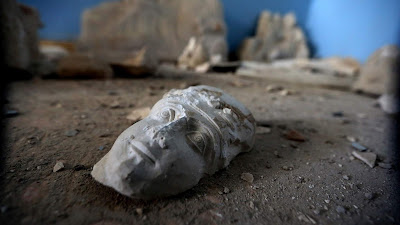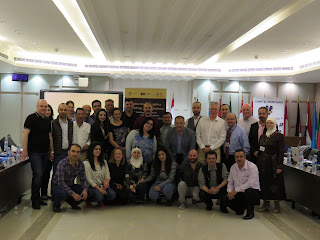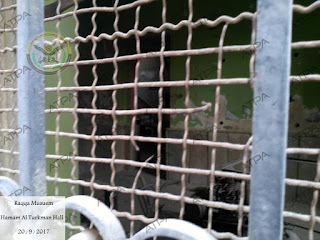 Adad-nerari III of Assyria,Assyrian,Bonhams,Christie's,Metropolitan Police,stela,stele,Swiss Federal Office of Culture,Syria,Tell Sheikh Hamad
Adad-nerari III of Assyria,Assyrian,Bonhams,Christie's,Metropolitan Police,stela,stele,Swiss Federal Office of Culture,Syria,Tell Sheikh Hamad
 No comments
No comments
A Case Study in Patience: The Long Journey Home for the Stela of Adad-nerari III
Back in the Spring of 2014, the art world found itself drawn to a particularly controversial object slated to come up for auction in Bonhams April's Antiquities sale in London. The piece was the lower two-thirds of a monumental black basalt stela which depicts an Assyrian king in a long-fringed cloak, holding his staff, surrounded by divine symbols. Incised across his body were twenty lines of evenly-spaced cuneiform script, with more text spilling over the sculpture's left side.
Listed as "a monumental Neo-Assyrian black basalt royal stele of Adad-nerari III of Assyria" the artefact was given an estimated sale price of between £600,000 to £800,000.
One inscription, carved with deliberate precision millennia ago, warned of divine retribution against anyone who uprooted the monument from its sacred setting. The irony was hard to miss: an ancient warning against plunder carried on a fragment plainly removed from its own archaeological context, its journey into the modern market underscoring that loss of context, while standing as evidence that plunder continues to drive today’s illicit antiquities trade, hidden by vague statements of ownership that try, and fail, to hide its true origins.
What made this sale contentious was not its dramatic epigraphy, but the serious questions raised about where and to whom this Assyrian piece could be traced. The stele in question dates to the reign of Adad-nīrārī III, King of Assyria from 811 to 783 BCE, a ruler whose period marked both consolidation and transition within the Neo-Assyrian Empire. Ascending the throne as a child, he initially ruled under the regency of his mother, the formidable Queen Šammuramat, often identified with the later Semiramis of classical legend.
Once in power, Adad-nīrārī III launched military campaigns across the Levant, extracting tribute from a wide arc of subject kingdoms and helping to reassert Assyria’s dominance after a period of instability. His inscriptions frequently emphasise divine sanction, royal piety and the restoration of order, themes that appear on the complete stela from which this fragment was once part. Objects bearing his name are valuable not only for their artistic and epigraphic qualities but also because they help us define and understand the extent of Assyria’s political reach under his rule.
Consigned to Bonhams through an intermediary, the stela would ultimately be traced by law enforcement to the then-Geneva-based Lebanese antiquities dealer Halim Korban. For those familiar with major art crime cases, his name may resonate for his involvement in the sale of the controversial Sevso Silver, the spectacular, but looted hoard of fourth-century Roman silver sold to the Marquess of Northampton and ultimately restituted to the Hungarian government in 2014.
Without any paperwork to substantiate how it left its country of origin and came into the possession of Korban, the Assyrian artefact was listed for auction with a simple but vague claim that the owner's father gifted him the ancient object "in the 1960s."
Archaeologists and art historians traced the find spot for the piece to the upper portion of the stela from ancient Du¯r-Katlimmu, modern Tell Sheikh Hamad in eastern Syria, on the lower Khabur River (Deir ez-Zor Governorate). That top portion was hauled away by Hormuzd Rassam, who visited the site in May 1879 during an expedition on behalf of the British Museum. Too heavy to transport across great distances, the controversial Assyriologist wrote:Eventually Rassam returned to England with a hacked-down, and significantly mutilated version of the upper portion of Adad-nīrārī's famous stela which has been housed in the British Museum's collection (inventory number: BM 131124) since 1881. While the explorer wanted to return to Syria to seek out the lower portion, Rassam was never granted permission to do so, and it is unclear how or when the lower portion was discovered and ultimately removed from the country without permission.
A year and a half after its seizure in London, another colourful Geneva-based diamond broker Emile Chayto was charged with fraud for falsely representing the provenance of the stela to disguise its theft and illegal export from Syria. One can speculate that Korban’s name had been intentionally omitted, as his name would have been an immediate red flag given the recent restitution of the Sevso treasure the same year of the auction.
In 2017, digging in his heels, the purveyor of the pilfered stela sued the Metropolitan Police's Commissioner, Bernard Hogan-Howe, in London for the artefact's return, even demanding £200,000 in compensation for alleged loss and damages. As the case moved from British to Swiss courts, Korban clung to a rather fanciful tale that the 930-kilogram monument had been in his family's hands since the 1930s and was brought to Switzerland in 1958 and then left for decades under a tarpaulin in his garden until he realised it might be worth something.
Despite his confidence, the dealer produced zero evidence to support this narrative, and the stela’s remarkably fine state of preservation suggested it had not spent half a century weathering the elements of a Western European backyard. Ultimately, following a multi-year investigation and examination by four other scholars, the Swiss Public Prosecutor’s Office concluded that the stele, by then sent back to Switzerland, was the product of illegal looting and ordered its restitution to the Republic of Syria.
This decision was upheld by the Court of Justice of the Canton of Geneva in a ruling published on 21 June 2024 noting that the decision taken in the lower court had relied on the concurring opinions of the four experts to conclude that the stela had been looted from Syria. This week the weighty memorial was transferred to the storage facility of the Swiss Federal Office of Culture, who is working on its transfer to the Republic of Syria in coordination with the Syrian authorities.
For the time being, a date of its return has not yet been announced, but the story of this Assyrian stele illustrates how even objects with colourful legends can sit at the heart of serious debates about the ethics of the contemporary antiquities trade. One of the most prominent being that two major auction houses didn't shy away from accepting this high value piece, no matter how poorly documented its legal origin had been and despite a growing legal framework that prioritises returning artefacts to their countries of origin when credible evidence of illicit transfer exists.
While this stela fragment’s return is now guaranteed, its legacy endures as a cautionary tale and a reminder that the market’s “curse” is not a supernatural hex etched into the stone honouring a long dead king, but the industry’s ongoing refusal to confront its legal and ethical responsibilities. Understanding provenance and respecting the rights of source communities are not optional flourishes but essential obligations. If the art market is to move beyond a profit-for-profit’s-sake model, it must embrace ethical dealing as a core practice rather than an inconvenience. Only then can art collecting and dealing claim a role in safeguarding, rather than exploiting, the world’s shared cultural heritage.








































